1993 CHEVROLET ASTRO PASSENGER ESP
[x] Cancel search: ESPPage 178 of 345
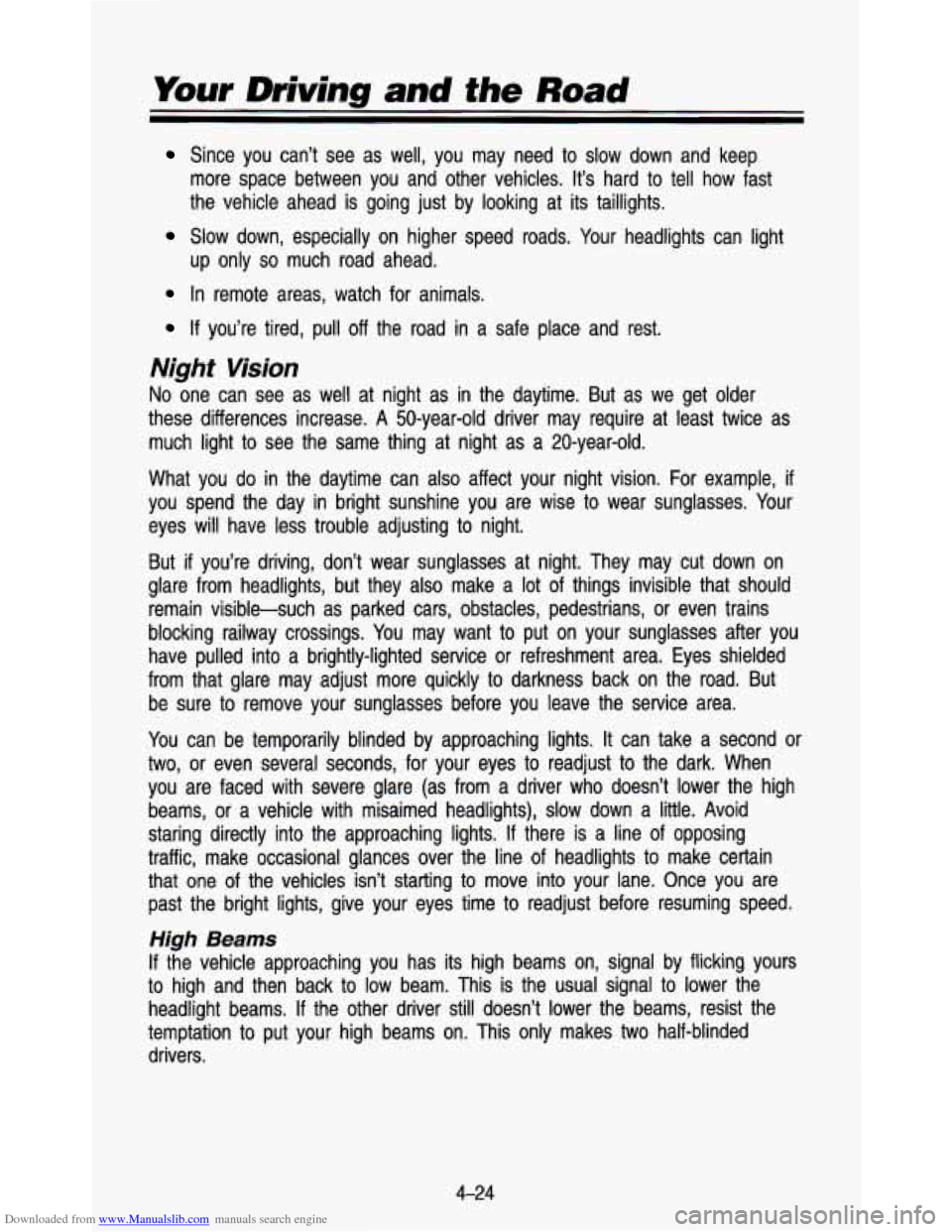
Downloaded from www.Manualslib.com manuals search engine Your Driving and the Road
Since you can’t see as well, you may need to slow down an\
d keep more space between you and other vehicles. It’s hard to tel\
l how fast
the vehicle ahead is going just by looking at its taillights. \
Slow down, especially on higher speed roads. Your headlights can light
up only
so much road ahead.
In remote areas, watch for animals.
If you’re tired, pull off the road in a safe place and rest.
Night Vision
No one can see as well at night as in the daytime. But as we \
get older
these differences increase.
A 50-year-old driver may require at least twice as
much light to see the same thing at night as a 20-year-old.
What you
do in the daytime can also affect your night vision. For example, if
you spend the day in bright sunshine you are wise to wear su\
nglasses. Your
eyes will have less trouble adjusting to night.
But
if you’re driving, don’t wear sunglasses at night. They may \
cut down on
glare from headlights, but they also make a lot of things inv\
isible that should remain visible-such as parked cars, obstacles, pedestrians,
or even trains
blocking railway crossings. You may want to put on your sunglasses after you
have pulled into a brightly-lighted service
or refreshment area. Eyes shielded
from that glare may adjust more quickly to darkness back on t\
he road. But be sure to remove your sunglasses before you leave the service area.
You can be temporarily blinded by approaching lights. It can take a second
or
two, or even several seconds, for your eyes to readjust to the dark. When
you are faced with severe glare (as from a driver who doesn’\
t lower the high beams,
or a vehicle with misaimed headlights), slow down a little. Avoid\
staring directly into the approaching lights.
If there is a line of opposing
traffic, make occasional glances over the line
of headlights to make certain
that one of the vehicles isn’t starting to move into your \
lane. Once you are past the bright lights, give your eyes time to readjust before resuming speed.
High Beams
If the vehicle approaching you has its high beams on, signal by \
flicking yours
to high and then back to low beam. This is the usual signal \
to lower the
headlight beams.
If the other driver still doesn’t lower the beams, resist the
temptation to put your high beams on. This only makes
two half-blinded
drivers.
4-24
Page 180 of 345
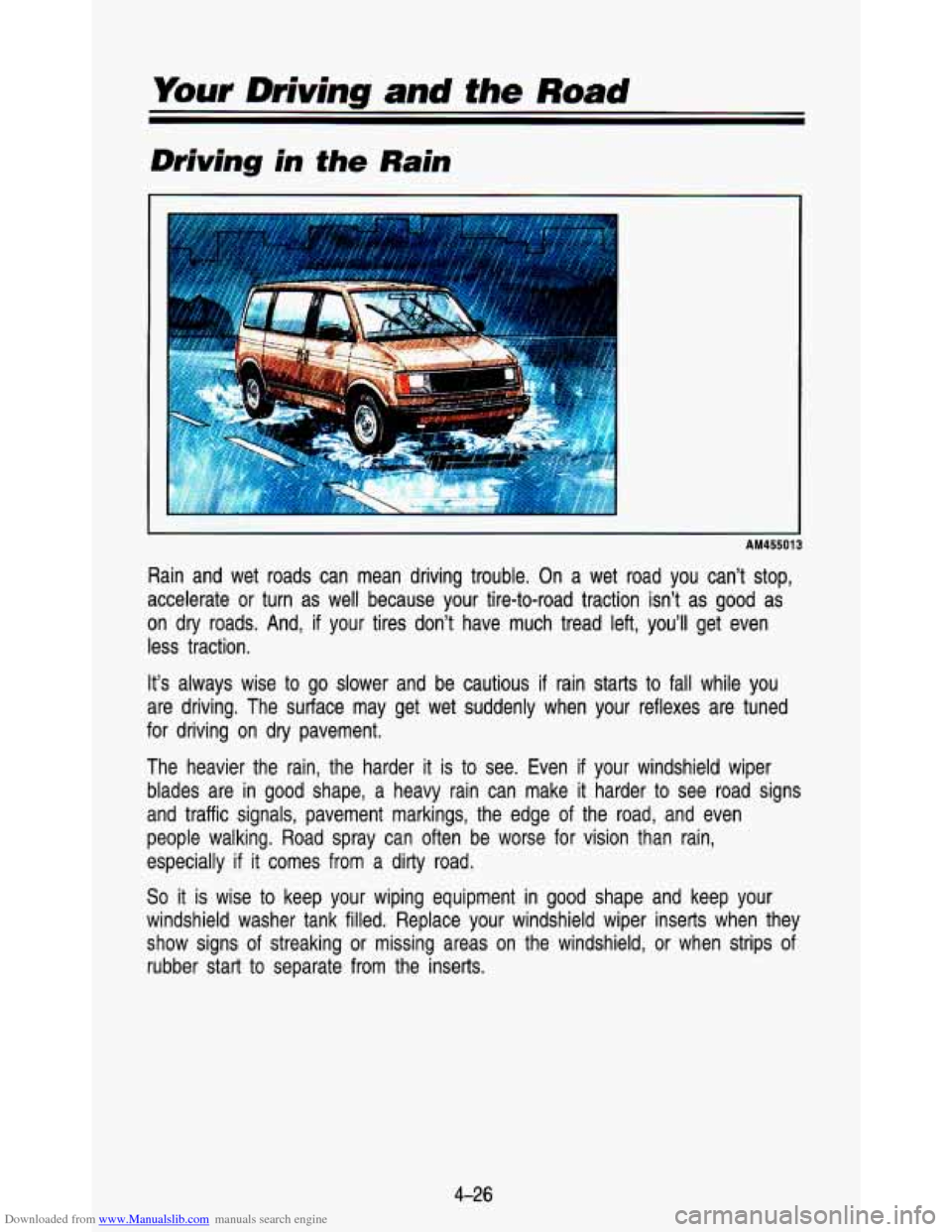
Downloaded from www.Manualslib.com manuals search engine Your Driving and #he Road
Driving in the Rain
1 I
I
Rain and wet roads can mean driving trouble. On a wet road y\
ou can’t stop,
accelerate or turn as well because your tire-to-road traction isn’t as good as
on
dry roads. And, if your tires don’t have much tread left, you’ll get even
less traction.
It’s always wise to go slower and be cautious
if rain starts to fall while you
are driving. The sutface may get wet suddenly when your reflexes a\
re tuned
for driving on dry pavement.
The heavier the rain, the harder
it is to see. Even if your windshield wiper
blades are in good shape, a heavy rain can make
it harder to see road signs
and traffic signals, pavement markings, the edge of the road, and even
people walking. Road spray can often be worse for vision than \
rain,
especially
if it comes from a dirty road.
So it is wise to keep your wiping equipment in good shape and keep your
windshield washer tank filled. Replace your windshield wiper inserts when \
they
show signs
of streaking or missing areas on the windshield, or when strips of
rubber start
to separate from the inserts.
4-26
Page 182 of 345
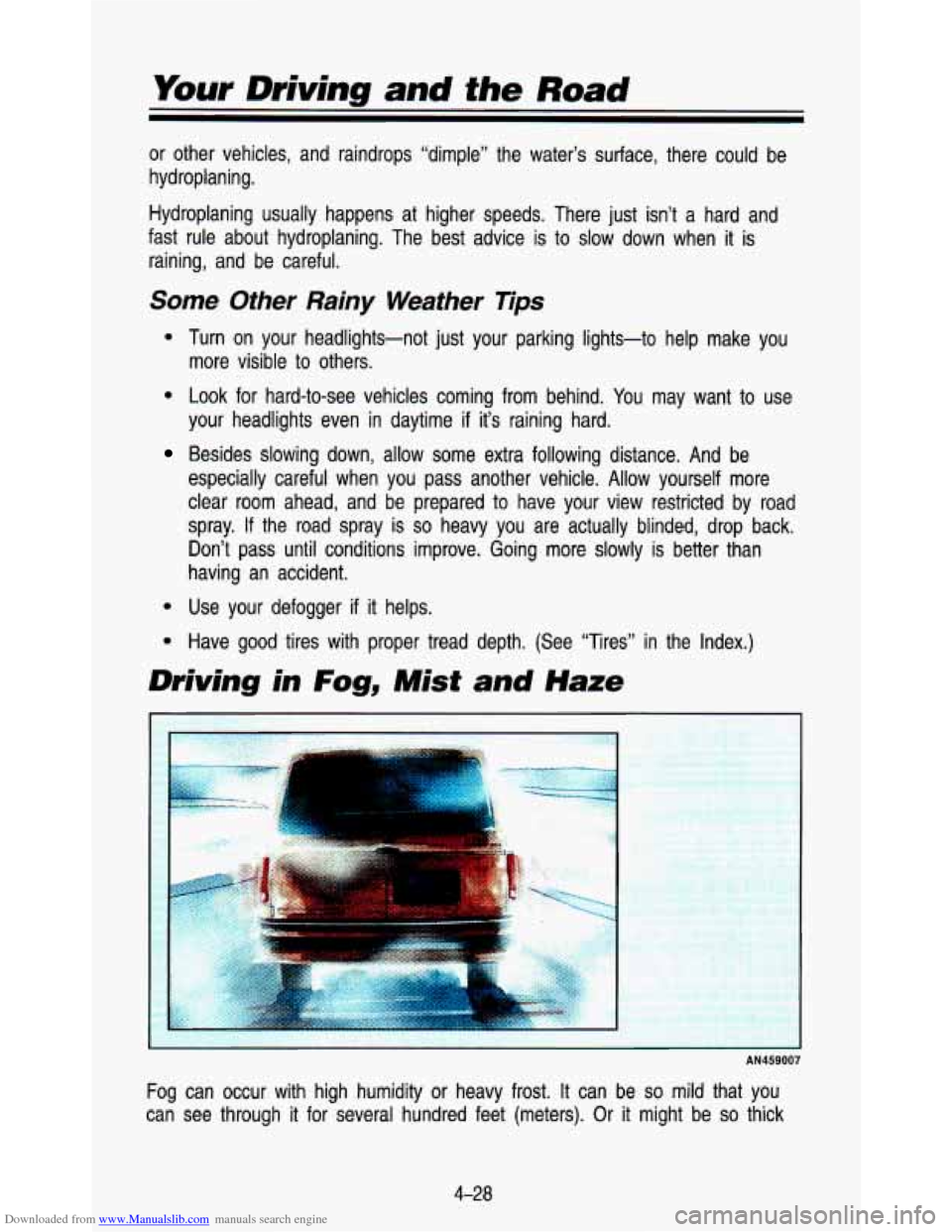
Downloaded from www.Manualslib.com manuals search engine Your Driving and the Road
or other vehicles, and raindrops “dimple” the water’s s\
urface, there could be
hydroplaning. Hydroplaning usually happens at higher speeds. There just isn’\
t a hard and
fast rule about hydroplaning. The best advice
is to slow down when it is
raining, and be careful.
Some Other Rainy Weather Tips
Turn on your headlights-not just your parking lights-to help ma\
ke you more visible
to others.
Look for hard-to-see vehicles coming from behind. You may want to use
your headlights even
in daytime if it’s raining hard.
Besides slowing down, allow some extra following distance. And \
be
especially careful when you pass another vehicle. Allow yourself\
more
clear room ahead, and be prepared
to have your view restricted by road
spray.
If the road spray is so heavy you are actually blinded, drop back.
Don’t pass until conditions improve. Going more slowly is be\
tter than
having an accident.
Use your defogger
if it helps.
Have good tires with proper tread depth. (See “Tires” in\
the Index.)
Driving in Fog, Mist and Haze
I ~
AN459007
Fog can occur with high humidity or heavy frost. It can be so mild that you
can see through
it for several hundred feet (meters). Or it might be so thick
4-28
Page 183 of 345
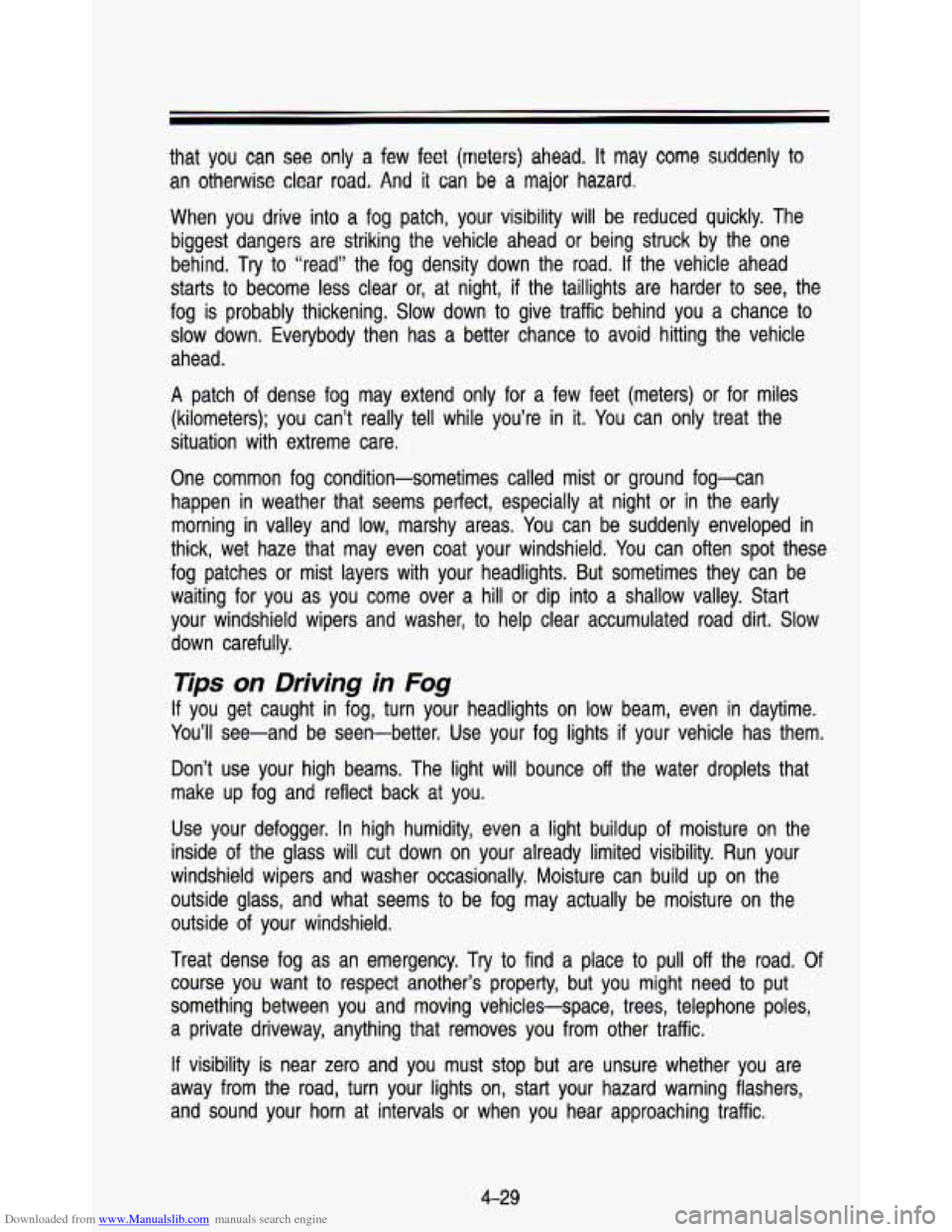
Downloaded from www.Manualslib.com manuals search engine that you can see only a few feet (meters) ahead. It may come suddenly to
an otherwise clear road. And it can be a major hazard.
When you drive into a fog patch, your visibility will be ieduced quickly. The
biggest dangers are striking the vehicle ahead
or being struck by the one
behind. Try
to “read” the fog density down the road. If the vehicle ahead
starts
to become less clear or, at night, if the taillights are harder to see, the
fog is probably thickening. Slow down to give traffic behind y\
ou a chance
to
slow down. Everybody then has a better chance to avoid hitting the vehicle
ahead.
A patch of dense fog may extend only for a few feet (meters) or for miles
(kilometers); you can’t really tell while you’re in
it. You can only treat the
situation with extreme care.
One common fog condition-sometimes called mist
or ground fog-can
happen in weather that seems perfect, especially at night
or in the early
morning in valley and low, marshy areas. You can be suddenly enveloped in
thick, wet haze that may even coat your windshield. You can often spot these
fog patches
or mist layers with your headlights. But sometimes they can be
waiting for you as you come over a hill
or dip into a shallow valley. Start
your windshield wipers and washer,
to help clear accumulated road dirt. Slow
down carefully.
Tips on Driving in Fog
If you get caught in fog, turn your headlights on low beam, even\
in daytime.
You’ll see-and be seen-better. Use your fog lights
if your vehicle has them.
Don’t use your high beams. The light will bounce
off the water droplets that
make up fog and reflect back at you.
Use your defogger. In high humidity, even a light buildup of moisture on the
inside
of the glass will cut down on your already limited visibility. Ru\
n your
windshield wipers and washer occasionally. Moisture can build up\
on the outside glass, and what seems to be fog may actually be moist\
ure on the
outside of your windshield.
Treat dense fog as an emergency.
Try to find a place to pull off the road. Of
course you want
to respect another’s property, but you might need to put
something between you and moving vehicles-space, trees, telephone poles,
a private driveway, anything that removes you from other traffi\
c.
If visibility is near zero and you must stop but are unsure whether you are
away from the road, turn your lights on, start your hazard warning flashers,
and sound your horn at intervals
or when you hear approaching traffic.
4-29
Page 184 of 345
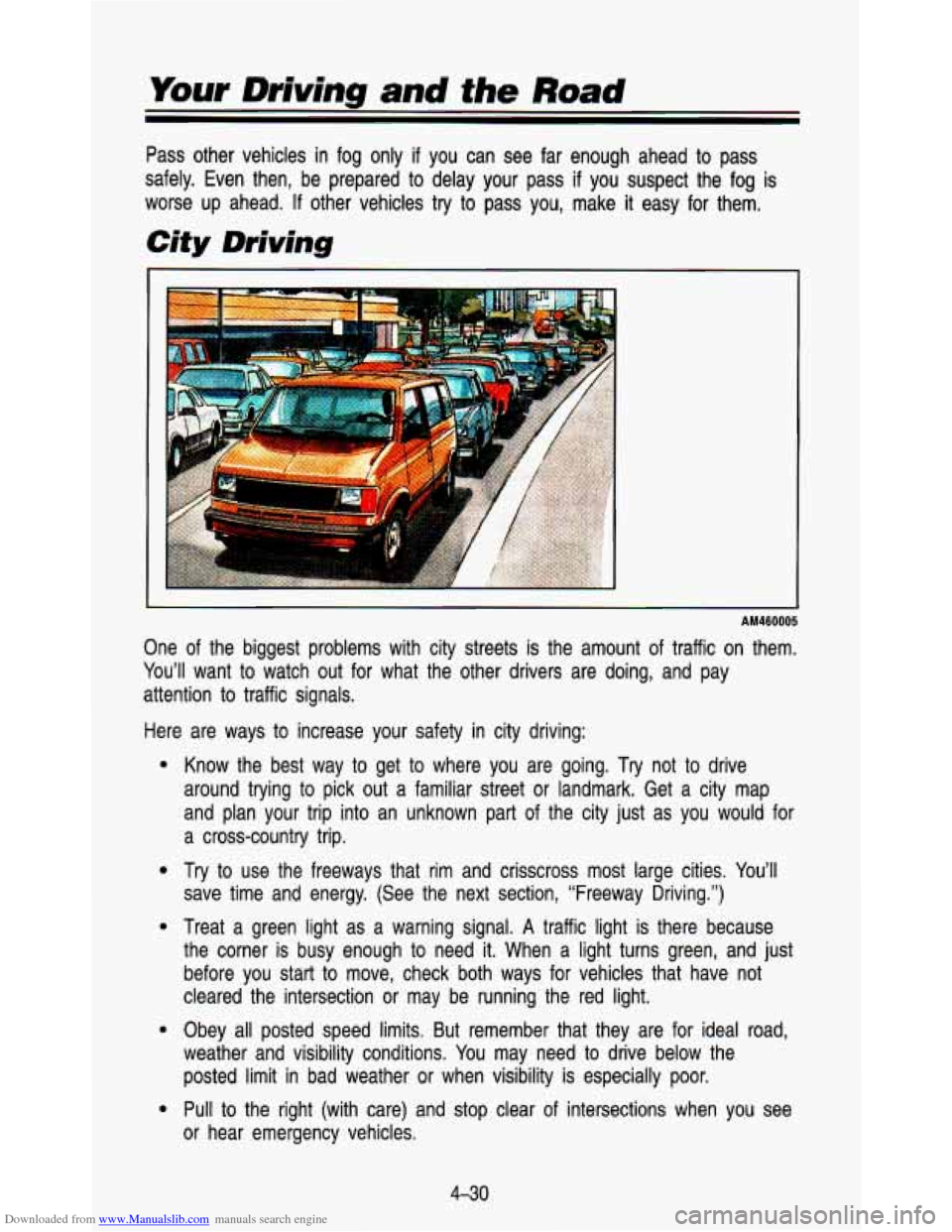
Downloaded from www.Manualslib.com manuals search engine Your Driving and the Road
Pass other vehicles in fog only if you can see far enough ahead to pass
safely. Even then, be prepared to delay your pass
if you suspect the fog is
worse up ahead.
If other vehicles try to pass you, make it easy for them.
City Driving
AM460005
One of the biggest problems with city streets is the amount of traffic on them.
You’ll want to watch out for what the other drivers are doing, and pay
attention to traffic signals.
Here are ways to increase your safety in city driving:
e
e
e
e
Know the best way to get to where you are going. Try not to drive
around trying to pick out a familiar street or landmark. Get \
a city map
and plan your trip into an unknown part of the city just as you would for
a cross-county trip.
Try to use the freeways that rim and crisscross most large cities. You’ll
save time and energy. (See the next section, “Freeway Drivi\
ng.”)
Treat a green light as a warning signal.
A traffic light is there because
the corner is busy enough to need
it. When a light turns green, and just
before you start to move, check both ways for vehicles that have not
cleared the intersection or may be running the red light.
Obey all posted speed limits. But remember that they are for ideal road,
weather and visibility conditions. You may need to drive below the
posted limit in bad weather
or when visibility is especially poor.
Pull to the right (with care) and stop clear of intersections when y\
ou see
or hear emergency vehicles.
430
Page 201 of 345
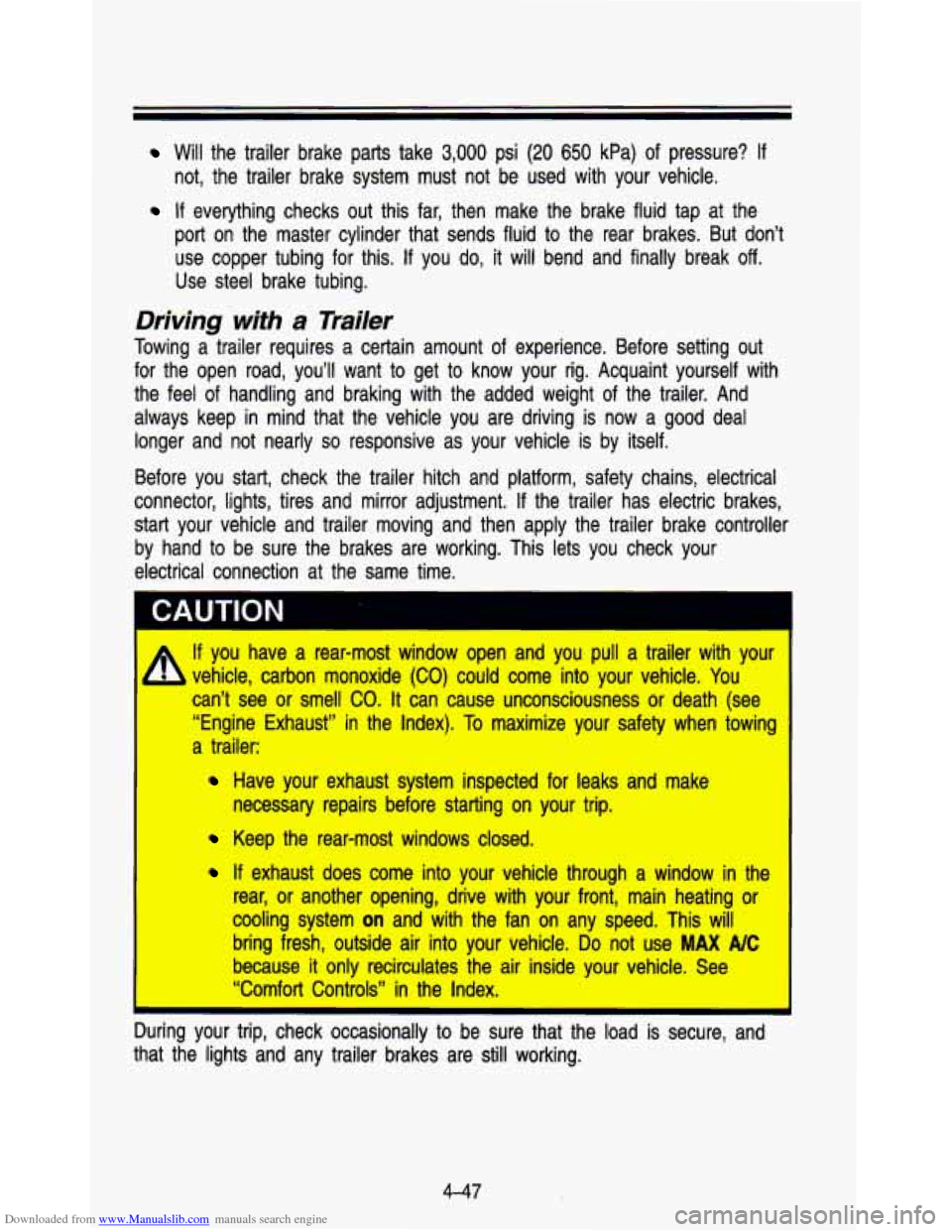
Downloaded from www.Manualslib.com manuals search engine Will the trailer brake parts take 3,000 psi (20 650 kPa) of pressure? If
not, the trailer brake system must not be used with your vehi\
cle.
if everything checks out this far, then make the brake fluid tap at the
port on the master cylinder that sends fluid to the rear brak\
es. But don’t use copper tubing for this.
If you do, it will bend and finally break off.
Use steel brake tubing.
Driving with a Trailer
Towing a trailer requires a certain amount of experience. Before setting out
for the open road, you’ll want to get to know your rig. Acquaint yourself with
the feel of handling and braking with the added weight of the trailer. And
always keep in mind that the vehicle you are driving is now a good deal
longer and not nearly
so responsive as your vehicle is by itself.
Before you start, check the trailer hitch and platform, safety \
chains, electrical
connector, lights, tires and mirror adjustment.
If the trailer has electric brakes,
start your vehicle and trailer moving and then apply the trail\
er brake controller
by hand to be sure the brakes are working. This lets you check your
electrical connection at the same time.
If you have a rear-most window open and you pull a trailer with your
vehicle, carbon monoxide (CO) could come into your vehicle. You
can’t see or smell CO. It can cause unconsciousness or death (see
“Engine Exhaust” in the Index).
To maximize your safety when towing
a trailer:
Have your exhaust system inspected for leaks and make
Keep the rear-most windows closed.
If exhaust does come into your vehicle through a window in the
rear, or another opening, drive with your front, main heating \
or
cooling system
on and with the fan on any speed. This will
bring fresh, outside air into your vehicle.
Do not use MAX NC
because it only recirculates the air inside your vehicle. See
“Comfort Controls” in the Index.
necessary repairs before starting
on your trip.
During your trip, check occasionally to be sure that the load is secure, and
that the lights and any trailer brakes are still working.
4-47
Page 203 of 345
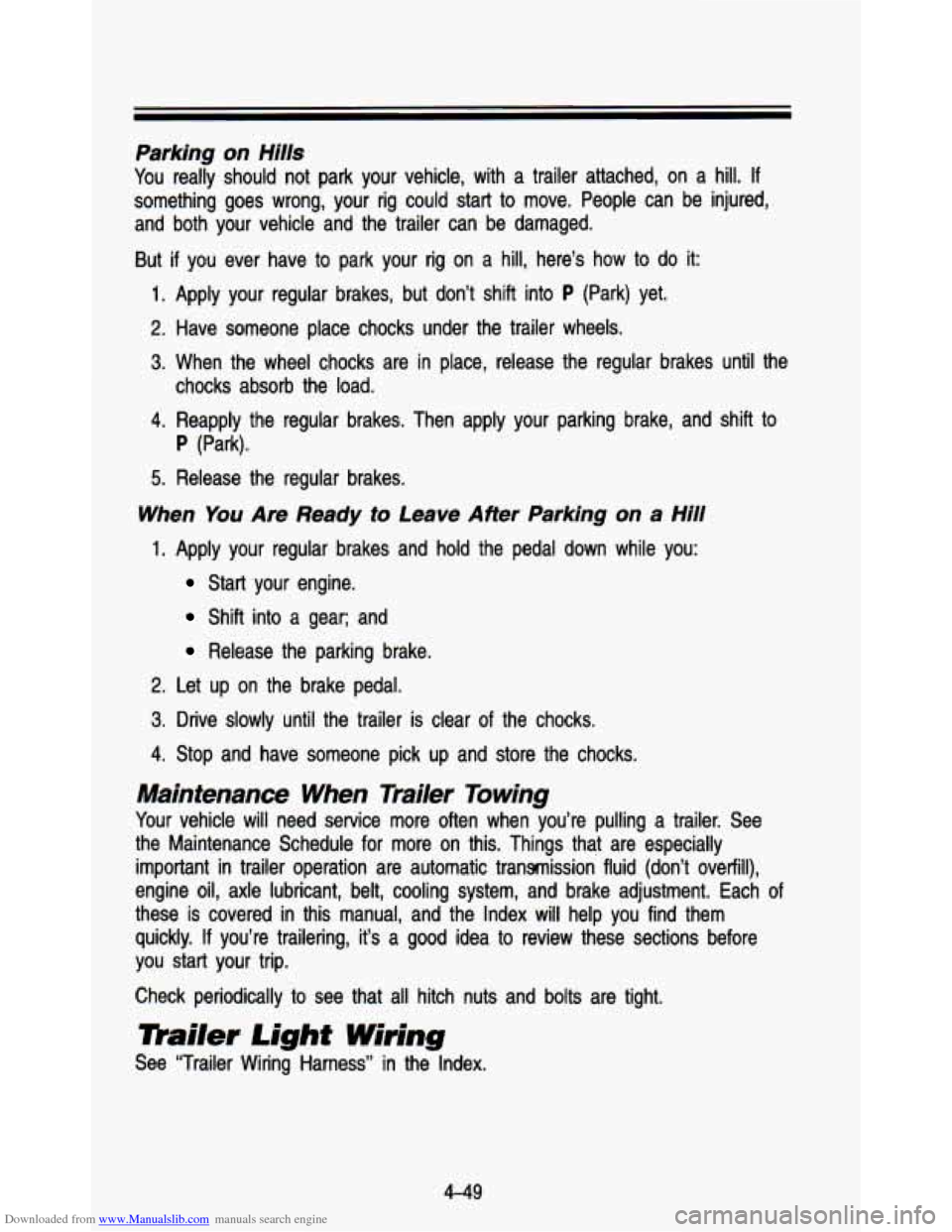
Downloaded from www.Manualslib.com manuals search engine Parking on Hills
You really should not park your vehicle, with a trailer attached, \
on a hill. If
something goes wrong, your rig could start to move. People can be injured,
and both your vehicle and the trailer can be damaged.
But
if you ever have to park your rig on a hill, here’s how to do it:
1. Apply your regular brakes, but don’t shift into P (Park) yet.
2. Have someone place chocks under the trailer wheels.
3. When the wheel chocks are in place, release the regular brakes until the
chocks absorb
the load.
4. Reapply the regular brakes. Then apply your parking brake, and \
shift to
P (Park).
5. Release the regular brakes.
When You Are Ready to Leave After Parking on a Hill
1. Apply your regular brakes and hold the pedal down while you:
Start your engine.
Shift into a gear; and
Release the parking brake.
2. Let up on the brake pedal.
3. Drive slowly until the trailer is clear of the chocks.
4. Stop and have someone pick up and store the chocks.
Maintenance When Trailer Towing
Your vehicle will need service more often when you’re pulling a trailer. See
the Maintenance Schedule for more
on this. Things that are especially
important in trailer operation are automatic transmission fluid (don’t ove\
rfill),
engine oil, axle lubricant, belt, cooling system, and brake adj\
ustment. Each of
these is covered in this manual, and the Index will help you find them
quickly. If you’re trailering, it’s a good idea
to review these sections before
you start your trip.
Check periodically
to see that all hitch nuts and bolts are tight.
mailer Light Wiring
See “Trailer Wiring Harness” in the Index.
4-49
Page 220 of 345
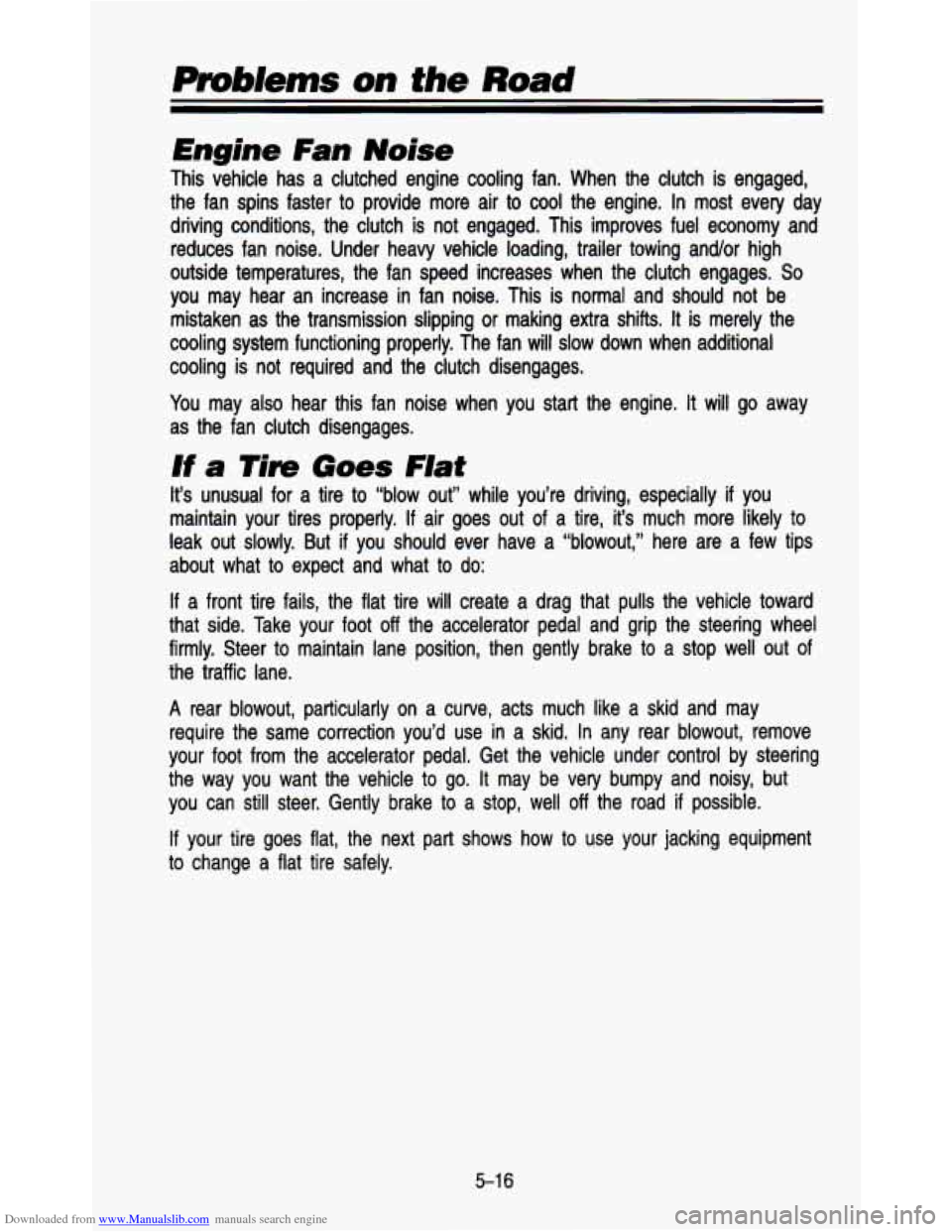
Downloaded from www.Manualslib.com manuals search engine Pmblems on the Road
Engine Fan Noise
This vehicle has a clutched engine cooling fan. When the clutc\
h is engaged,
the fan spins faster
to provide more air to cool the engine. In most every day
driving conditions, the clutch is not engaged. This improves fu\
el economy and
reduces fan noise. Under heavy vehicle loading, trailer towing \
andlor high
outside temperatures, the fan speed increases when the clutch e\
ngages.
So
you may hear an increase in fan noise. This is normal and should not be
mistaken as the transmission slipping
or making extra shifts. It is merely the
cooling system functioning properly. The fan will slow down whe\
n additional
cooling is not required and the clutch disengages.
You may also hear this fan noise when you start the engine.
It will go away
as the fan clutch disengages.
If a Tim Goes Flat
It’s unusual for a tire to “blow out” while you’re driving, especially if you
maintain your tires properly.
If air goes out of a tire, it’s much more likely to
leak out slowly. But
if you should ever have a “blowout,” here are a few tips
about what to expect and what
to do:
If a front tire fails, the flat tire will create a drag that pulls the vehicle toward
that side. Take your foot
off the accelerator pedal and grip the steering wheel
firmly. Steer
to maintain lane position, then gently brake to a stop well out of
the traffic lane.
A rear blowout, particularly on a curve, acts much like a skid \
and may
require the same correction you’d use in a skid. In any rear blowout, remove
your foot from the accelerator pedal. Get the vehicle under co\
ntrol by steering
the way you want the vehicle
to go. It may be very bumpy and noisy, but
you can still steer. Gently brake
to a stop, well off the road if possible.
If your tire goes flat, the next part shows how to use your jacking equipment
to change a flat tire safely.
5-1 6